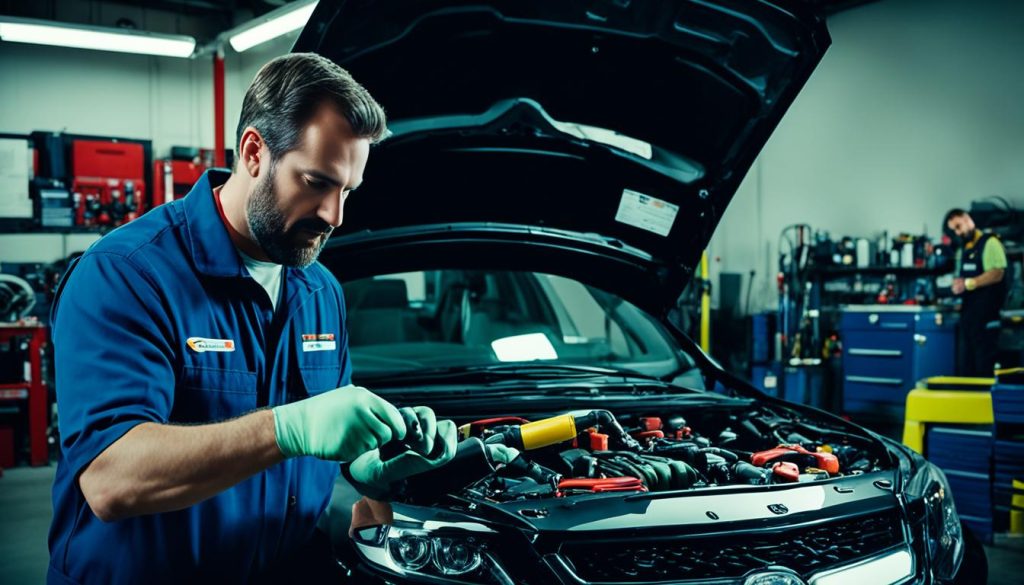
When to Repair vs. When to Replace: Making the Right Decision

Winter Driving Tips: Avoiding and Handling Collisions
Many road traffic accidents occur with workers, causing serious harm every week. As fleet managers, it’s essential to push for road safety. We should take steps to lower the chances of accidents. Our vehicles are important, so keeping drivers and others safe is key.
This article will dive into tactics to boost safety for your fleet on the road. By using these solutions, you can cut down on accidents. This way, the road becomes safer for everyone.
Key Takeaways:
- Road traffic accidents are a big issue, especially for workers on the road, making safety a must for fleet managers.
- Using the right strategies improves safety and lessens accidents for your fleet.
- Making safety a part of your work culture is vital to protect drivers and other people on the road.
- Choosing safety measures protects your valuable vehicles and keeps accidents’ harm low.
- Prioritizing safety makes the road safer, benefiting your drivers’ health and your business’s success.
Making the road safe is not just about rules; it’s about doing what’s right. Let’s work to better our fleet vehicles’ safety.
Next, we’ll cover cutting down trips to make your fleet safer.
Reducing and Optimizing Journeys
Making your fleet’s journeys shorter and smarter keeps the roads safer. This means cutting out trips that aren’t needed. It also means making the ones you do take, shorter.
Using tools that help manage your fleet is key. They give you info and tips on how to move your vehicles better. This can include planning the best routes and using your resources wisely.
These tools help you use your vehicles better. They spot where you can combine trips, so fewer vehicles are on the road. Less traffic means lower accident risks, saving money, and running more smoothly.
They also help track things like traffic and bad weather. By knowing about problems fast, you can reroute your vehicles. This helps your drivers have easier trips and fights off dangers.
The tools look at how your drivers drive, like their speed. If they need to improve, you can offer training. This makes driving safer for everyone.
So, these strategies mean your vehicles are on the road less. That cuts the chances of accidents. It keeps your drivers, and others, safer. And it shows your business as one that cares about safety and is reliable.
In the next part, we’ll talk about making driving greener and training drivers. This helps make the roads safer for your fleet.
Promoting Eco-Driving and Driver Training
By championing eco-driving, you make road safety better for your fleet. These methods cut down on fuel use, lessen pollution, and make your business run smoother. Eco-driving is all about acting responsibly when you drive and take good care of your vehicle.
Tools like in-cab coaches and feedback devices are key in pushing for eco-driving. They warn drivers about bad habits on the spot, like going too fast or braking hard. This way, drivers learn to drive better, making the roads safer for everyone.
Using fleet management solutions is crucial for pushing eco-driving and training drivers. These tools note which drivers are risky and what bad habits they have. Then, managers can give each driver personalized advice on how to drive safer. This focus helps drivers kick bad habits and pick up good ones.
Teaching eco-driving and investing in driver training builds a culture of safety in your fleet. This not only lowers the chance of accidents but also saves money and helps the planet. Making eco-driving and training top priorities shows you care about safety and being a good corporate citizen.

Benefits of Promoting Eco-Driving and Driver Training:
- Enhanced road safety for drivers, passengers, and other road users
- Reduced fuel consumption and lower carbon emissions
- Improved fleet efficiency and cost savings
- Minimized vehicle wear and tear, leading to decreased maintenance expenses
- Positive environmental impact and sustainability
Going green with your fleet and giving drivers good training leads to safer roads and better business. Joining these green efforts protects your team, your vehicles, and the places your business goes. Start using these methods now for a brighter future for all.
Ensuring Vehicle Maintenance and Monitoring Phone Use
Taking care of vehicles well is key to avoiding accidents. It’s crucial to match the right vehicle to its job and route. Regular checks help catch and fix any issues early. This way, we lower the risk of breaking down on the road.
Watching how drivers use phones is just as important for safety. Using phones while driving can lower a driver’s focus and quick thinking. Tools that monitor fleets in real-time help stop phone use. This keeps drivers paying attention to driving.

Teaching drivers to first check their surroundings before calling makes the road safer. Cutting out phone use during driving boosts safety. It also builds a culture of cautious driving in our team.
Providing Assistance and Identifying Dangerous Road Sections
Fleet management services are key to keeping your fleet vehicles safe. They offer quick access to help after an accident. This includes features like E-call buttons and collision detection which are lifesavers.
E-call buttons are there for drivers to call emergency services fast. This quick action helps lower the risk and damage from accidents. When the authorities know right away, they can send help. This ensures your drivers and others involved are safe.
Fleet managers also use data to spot dangerous road spots. They look at accident zones, road conditions, and past problems. This helps them know which areas are risky for drivers.
With this data, managers can then plan safer routes. Choosing other ways avoids trouble spots. Doing this cuts down on accidents. It makes your drivers’ trips safer.
Using a full fleet management system means you can give accident help and spot dangerous roads. This helps with route planning, making operations run smoother. It’s good for safety and your whole business.
Image:
By including tools for accident help and route planning, you make your drivers safer. This boosts road safety for your whole fleet.
Conclusion
Implementing the strategies here can really boost road safety for your fleet. By cutting down on journeys, teaching eco-driving, and keeping up with maintenance, you’ll make the roads safer. This ensures your drivers are in a safer environment and cuts down the chance of accidents.
Making fewer trips means less road time and lower accident risks. Teaching eco-driving and having driver training promotes safer driving habits. This helps make sure everyone is driving more safely.
It’s vital to keep vehicles in good shape for safety. Regular maintenance and quick fixes cut down on accidents. Also, keeping an eye on phone use keeps drivers focused on driving.
Helping out if there’s a crash is key. Tools like E-call and collision detection offer quick help. Finding out which roads are risky lets you plan safer routes to avoid danger.
Don’t forget, putting safety first is crucial for both your drivers and your business’s success. Use these steps to improve your fleet’s safety. This way, you can lower the chances of accidents for everyone on the road.



